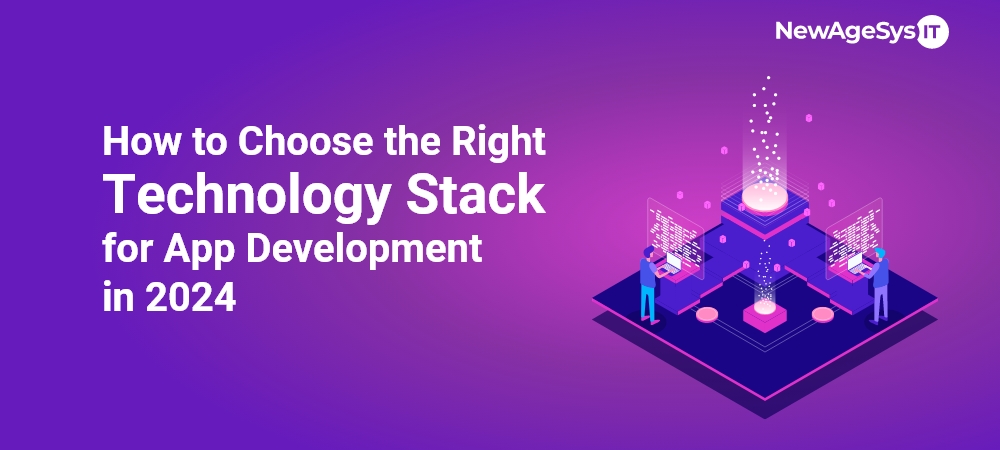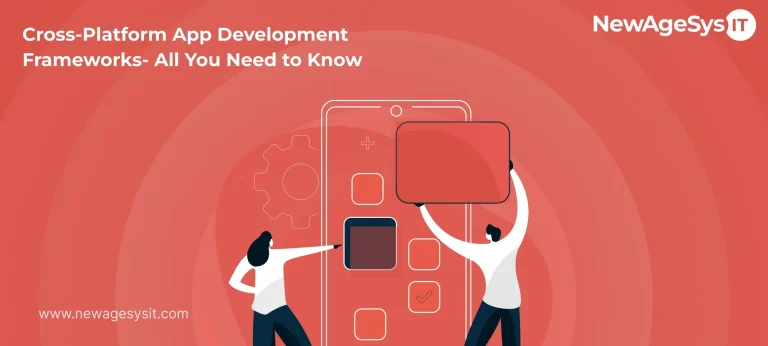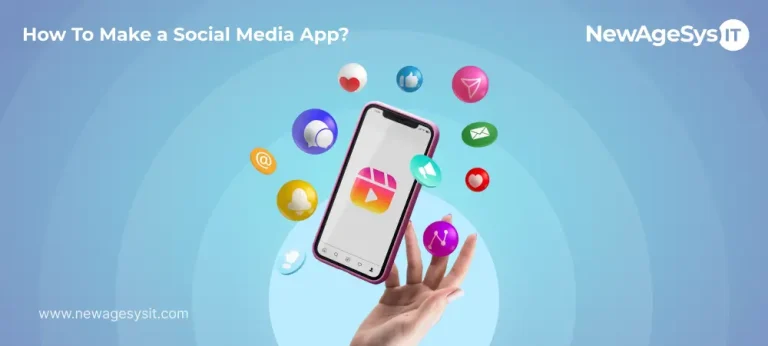Are you aiming to turn your app idea into reality? Excellent! What’s the initial step you plan to take? Undoubtedly, selecting the appropriate tech stack serves as the cornerstone for your application. A tech stack encompasses the programming languages, frameworks, tools, and platforms necessary for running the app. Importantly, the tech stack you opt for can significantly impact aspects such as cost, speed, performance, and maintenance, not to mention user experience and ensuring your mobile app remains future-proof.
So, what will you choose? There are three primary approaches to mobile app stack development: native, hybrid, and cross-platform. Each of these approaches boasts its advantages, features, and constraints. It’s crucial to remember that the optimal tech stack for your app largely hinges on your specific requirements and objectives.
Are you excited to delve deeper into selecting the Right Technology Stack for App Development? Then, this blog is tailored for you. Within this blog, you’ll gain insights to determine the most suitable and optimal tech stack for your app.
Understanding Technology Stacks
Picture a towering skyscraper, each level upheld by a meticulously designed framework of steel and concrete. Similarly, a technology stack serves as the architectural framework of your app, composed of tiers of software components, frameworks, programming languages, and tools necessary for its assembly. In essence, a tech stack is a blend of technologies and tools required to operate a software application, be it a website or a mobile app, consisting of various layers.
Types of Technology Stacks
Full Stack
A full-stack tech stack refers to the entire set of technologies used to build a web application, encompassing both the user experience (frontend) and the server-side functionality (backend). This makes full-stack developers well-rounded individuals who can manage all aspects of the development process.
Frontend Stack
The frontend tech stack is the set of tools and technologies that bring a web application’s user interface (UI) and user experience (UX) to life. It’s all about what users see and interact with on their screens. It incorporates technologies like HTML, CSS, and JavaScript.
Backend Stack
Manages server-side operations, databases, and business logic, including technologies such as programming languages (e.g., Python, Ruby, or Java), web frameworks (e.g., Django or Rails), and database management systems (e.g., MySQL or PostgreSQL).
Platform
The mobile platform (e.g., iOS or Android) furnishes the operating system and development tools utilized in app construction and execution. This may involve technologies like the iOS SDK or Android SDK and programming languages such as Objective-C, Swift, Java, or Kotlin.
Hosting
The hosting environment executes the server-side code and serves the app to users, potentially encompassing elements like Linux, Apache, and Amazon Web Services (AWS).
Difference between mobile and web app development technology stacks
While mobile and web applications adhere to foundational principles, their technology stacks diverge significantly and present distinct differences to contemplate.
Mobile App Stack
Typically entails languages like Swift (for iOS) or Kotlin (for Android), combined with platform-specific development frameworks.
Web App Stack
Relies on HTML, CSS, and JavaScript, frequently leveraging popular frameworks such as React, Angular, or Vue.js for frontend development, and various backend technologies like Node.js, Django, or Flask.
Platform
A primary discrepancy lies in accessibility; web apps can be accessed from anywhere and can utilize more cross-platform technologies as they operate within web browsers. Conversely, mobile apps are specifically tailored to platforms like iOS or Android, necessitating platform-specific tools and frameworks.
Programming Languages
Mobile apps utilize native programming languages like Objective-C or Swift for iOS and Java or Kotlin for Android. Conversely, web apps can be constructed with a variety of programming languages, including Python, Ruby, Java, and JavaScript.
Frameworks
Frameworks for mobile app development are tailored to the platform they serve, whereas web app development frameworks can be employed across multiple platforms. For instance, iOS apps may utilize frameworks like SwiftUI, while Android apps can leverage frameworks like Android SDK or Flutter. Web apps are developed using frameworks such as Rails, Django, or ASP.NET.
User Interface
Mobile apps feature interfaces optimized for the specific screen size and user input methods of the device they operate on. Conversely, web apps possess responsive interfaces designed to adapt to various device sizes and input methods.
Distribution
Mobile apps are typically disseminated through app stores, whereas web apps can be accessed directly via web browsers. This discrepancy impacts app maintenance, updates, and monetization strategies.
Factors to Consider when Selecting a Tech Stack for Your Mobile App
Application Type
The nature of your application is paramount in determining the appropriate tech stack. Simple apps with limited features may not necessitate a complex tech stack, whereas more sophisticated apps with advanced functionalities may require a more robust tech infrastructure.
Platform Compatibility
Selecting a platform entails choosing a compatible tech stack that supports it. Whether developing for iOS, Android, or both, opt for a tech stack aligned with the targeted platform. Native development caters best to specific platforms, while hybrid or cross-platform approaches accommodate multiple platforms.
Features and Functionality:
Consider the features and functionalities you intend to integrate into your app, as certain tech stacks may be better suited for specific functionalities like gaming, augmented reality, or machine learning.
Budget and Resources
Your budget and available resources, including time, expertise, and development team, significantly influence tech stack selection. Native development can be costlier and time-intensive, whereas hybrid or cross-platform approaches offer faster and more cost-effective alternatives.
Maintenance and Scalability
Choose a tech stack conducive to future growth, ensuring scalability and ease of maintenance. Factors such as server choices, hosting providers, databases, and programming languages profoundly impact app expansion and scalability.
How to Select the Right Tech Stack
Native App Development
Native applications offer unmatched performance and access to native device functionalities, making them ideal for resource-intensive applications requiring top-tier performance and user experience.
Building apps for mobile devices like iPhones or Android phones involves using toolkits and programming languages designed specifically for each platform. These toolkits, called SDKs (Software Development Kits), provide everything you need to create an app that works seamlessly with that particular operating system.
For iOS apps
- Swift serves as the primary programming language, known for its power, modernity, and ease of use.
- Xcode serves as the primary development environment, offering a robust suite of tools including a code editor, debugger, and testing utilities.
- The iOS SDK comprises a range of tools and frameworks such as UIKit, Foundation, and Core Graphics, facilitating various aspects of app development.
- UIKit provides essential user interface elements and tools necessary for building iOS apps, offering components like buttons, labels, tables, and collection views.
- Other commonly used technologies in iOS app development include databases like SQLite or Core Data, networking libraries such as AFNetworking or Alamofire, and testing frameworks like XCTest or Quick.
For Android apps
- Java is the primary programming language, offering power and versatility with its object-oriented nature.
- Android Studio serves as the primary development environment, providing a comprehensive suite of tools for building and testing Android apps.
- The Android SDK encompasses various tools and frameworks, including UI elements, data storage, and networking functionalities.
- The Android framework consists of APIs providing core functionalities for Android apps, covering areas like view management, touch handling, and event management.
- Kotlin, a modern statically typed language interoperable with Java, has gained popularity among Android developers, endorsed by Google as its preferred language for Android development and fully supported by Android Studio.
Hybrid App Development
Hybrid app development strikes a balance between cross-platform compatibility and native functionality by utilizing web technologies such as HTML, CSS, and JavaScript. Frameworks like Cordova, PhoneGap, or Ionic package the app into a native container, granting access to native device features. While hybrid app development is generally faster and more cost-effective than native development, it may result in slightly slower performance and a less native-like user experience.
Cross-platform App Development
Cross-platform app development employs frameworks like Flutter, Xamarin, or React Native to create apps that seamlessly run across multiple platforms. It offers benefits like code reusability and accelerated development cycles. At the same time, generally faster and more cost-effective than native development, cross-platform app development may entail some trade-offs in performance and user experience.
Technology Stacks Employed by Companies for Their Mobile Applications
Predominantly constructed using React Native to facilitate swift development and iterative processes.
Instead of a one-size-fits-all approach, Facebook dives deep into native development for their iOS and Android apps. This means they have separate sets of code written in languages specific to each platform. Apple devices might use Objective-C or Swift, while Android is Java or Kotlin.
Uber
Uber adopts a native technology stack for its primary iOS and Android applications, featuring distinct codebases scripted in Objective-C, Swift, Java, and Kotlin. These applications utilize native development frameworks such as UIKit (iOS) and Android SDK (Android), in addition to third-party libraries and tools like RxJava and Retrofit.
Twitter utilizes a native technology stack for its main iOS and Android applications, featuring separate codebases composed in Objective-C, Swift, Java, and Kotlin. These applications harness native development frameworks such as UIKit (iOS) and Android SDK (Android), alongside third-party libraries and tools such as Fabric and Crashlytics.
Airbnb
Airbnb employs a hybrid technology stack for its iOS and Android applications, boasting a unified codebase scripted in JavaScript and compiled into native code utilizing the React Native framework. These applications also leverage native development frameworks like UIKit (iOS) and Android SDK (Android) for specific platform-centric functionalities.
Why Choose NewAgeSysIT for App Development
At NewAgeSysIT, we integrate innovation with expertise to provide customized app development solutions that meet your specific needs. Our team of experienced developers utilizes cutting-edge technologies and industry best practices to actualize your vision, guaranteeing a seamless user experience and optimal market impact.
Tailored Solutions:
We tailor our app development solutions to align with your requirements and objectives.
Expertise:
Our seasoned team of developers possesses extensive experience and expertise in a diverse range of technologies, ensuring that your app is developed using the most suitable and efficient methods available.
Quality Assurance
We adhere to rigorous quality assurance processes throughout the development lifecycle to deliver flawless, high-performance apps that exceed your expectations.
Timely Delivery:
We understand the importance of deadlines. Our agile development approach enables us to deliver projects on time, ensuring that you can launch your app within the desired timeframe.
Ongoing Support:
Our relationship with you doesn’t end with the launch of your app. We provide ongoing support and maintenance services to ensure that your app remains up-to-date and functional in the ever-evolving digital landscape.
Final Thoughts
The foundation of your app, the tech stack you choose, plays a major role in determining its future. By carefully evaluating your project requirements, exploring different options, and leveraging the expertise of experienced professionals like those at NewAgeSysIT, you can set yourself on the path to app development excellence and digital innovation. Head over to our case studies and testimonials and see how our software solutions helped clients to grow.
























